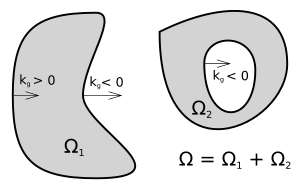Gauss–Bonnet theorem facts for kids
The Gauss–Bonnet theorem is a very important idea in a part of math called differential geometry. It connects the shape of a surface (how much it curves) to its basic structure (like if it has holes or not).
Think about a simple triangle on a flat piece of paper. You know that the angles inside it always add up to 180 degrees. The Gauss–Bonnet theorem takes this idea and makes it work for more complicated shapes and surfaces that are curved, like a ball or a bumpy hill. It helps us understand how local curves on a surface relate to the overall shape of that surface.
This theorem is named after two smart mathematicians: Carl Friedrich Gauss, who thought of a version but didn't publish it, and Pierre Ossian Bonnet, who published a specific part of it in 1848.
Contents
What the Theorem Says
The Gauss–Bonnet theorem basically says that if you add up all the tiny bits of curvature across a surface, and then add the curvature along its edges, you get a number that tells you something about the surface's overall shape.
This "overall shape" is described by something called the Euler characteristic. It's a number that helps classify surfaces based on how many "holes" they have. For example, a sphere (like a ball) has an Euler characteristic of 2, and a donut shape has an Euler characteristic of 0.
The theorem is often written as a math formula, but the main idea is simple:
- The total Gaussian curvature of the surface (how much it bends at each point).
- Plus the total geodesic curvature along its boundary (how much its edges curve).
- Equals a number related to the surface's Euler characteristic (its basic shape).
If the edge of the surface has sharp corners, like a triangle, you also add up the angles at those corners.
A Simple Example
Let's look at some examples to make this clearer.
Northern Hemisphere
Imagine the top half of a sphere, like the northern hemisphere of Earth.
- Its Euler characteristic (its basic shape number) is 1.
- The curvature of a sphere is the same everywhere.
- The edge of the hemisphere is the equator. The equator is a "geodesic" on a sphere, meaning it's the shortest path between two points on the surface, so its geodesic curvature is zero.
- If you add up the curvature over the whole hemisphere, you get a certain value.
Flattened Hemisphere
Now, imagine you could flatten that hemisphere into a flat disk, like a pancake.
- It's still the same basic shape (Euler characteristic is still 1).
- But now, the flat disk has no curvature in the middle (Gaussian curvature is zero).
- The edge of the disk is a circle. A circle on a flat surface is not a geodesic (a straight line), so it has geodesic curvature.
- If you add up the curvature along the edge of the disk, you get the same value as the total curvature of the hemisphere! This shows how the theorem connects the two.
Sphere Octant
Think about one-eighth of a sphere, like a slice of an orange.
- This shape is also similar to the previous examples in terms of its basic structure.
- The edges of this slice are parts of "great circles" (like lines of longitude on Earth), which are geodesics on the sphere. So, the geodesic curvature along most of the edge is zero.
- However, this slice has three right-angle corners where the edges meet. The theorem accounts for these sharp turns.
- When you add up the curvature over the surface and the turns at the corners, it again matches the Euler characteristic.
For Triangles
The Gauss–Bonnet theorem is often used for "geodesic triangles." These are like regular triangles, but their sides are the shortest paths on a curved surface (called geodesics).
On a flat surface, the sides of a triangle are straight lines, and the angles add up to 180 degrees (or π radians).
On a curved surface, things change:
- On a sphere, like a globe, the sides of a geodesic triangle are parts of great circles. The angles inside a spherical triangle always add up to more than 180 degrees. The extra amount is related to the area of the triangle and the sphere's curvature. This is known as Girard's theorem.
- On a hyperbolic surface (which curves in a different way, like a saddle), the angles inside a geodesic triangle always add up to less than 180 degrees. The missing amount is related to the area and the surface's curvature. This was discovered by Johann Heinrich Lambert.
The Gauss–Bonnet theorem explains why these angle sums are different on curved surfaces compared to a flat plane.
Special Cases
Many older discoveries about shapes on spheres and other curved surfaces are actually special cases of the Gauss–Bonnet theorem.
Polyhedra
Descartes' theorem on total angular defect is like the Gauss–Bonnet theorem for shapes made of flat faces, straight edges, and sharp corners, like a polyhedron (think of a dice or a pyramid).
This theorem says that if you add up the "defect" at all the corners (vertices) of a polyhedron that's shaped like a sphere, you always get a specific value (4π). The "defect" is how much the angles around a vertex fall short of a full circle.
More generally, if a polyhedron has "holes" (like a donut-shaped object), the sum of these defects changes based on the number of holes. This shows how the Gauss–Bonnet theorem can apply even when curvature is concentrated at specific points, not spread smoothly over a surface.
See also
 In Spanish: Teorema de Gauss-Bonnet para niños
In Spanish: Teorema de Gauss-Bonnet para niños
- Chern–Gauss–Bonnet theorem
- Atiyah–Singer index theorem


